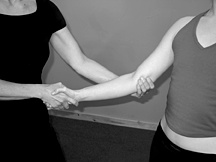Introduction
Pronator Teres Syndrome (PTS) is a compression neuropathy of the median nerve at the elbow. It is not as common as compression at the wrist which is Carpal Tunnel Syndrome (CTS).
Purpose
The purpose of this test is to help differentiate between Pronator Teres Syndrome and Carpal Tunnel Syndrome.
Clinical Signs
Compression of the medial nerve at the elbow can lead to pain and/or numbness in the distribution of the distal median nerve and weakness can develop in the flexor pollicus longus and flexor digitorum profundus of the index finger and the pronator quadratus.
The physical findings of this would be tenderness over the pronator teres muscle and pain with resisted pronation of the forearm. Weakness could be present with abduction of the thumb as well as impairment to the pincer muscles. Sensation changes may also be experienced in the first three fingers and the palm.
Technique
The patient stands with the elbow in 90 degrees of flexion. The clinician then places one hand on the client’s elbow for stabilization and the other hand grasps the patient’s hand in a handshake position. The client holds this position as the practitioner attempts to supinate the patient’s forearm (forcing the client to contract the pronator muscles). While holding the resistance against pronation, the clinician extends the patient’s elbow. If the patient’s pain or discomfort is reproduced, there is a good chance of median nerve compression by the pronator teres. The patient should keep the elbow relaxed during the test, because holding the elbow firmly in flexion will not allow elbow extension.
Evidence
Provide the evidence for this technique here
Resources

